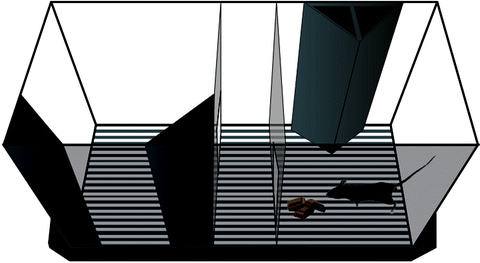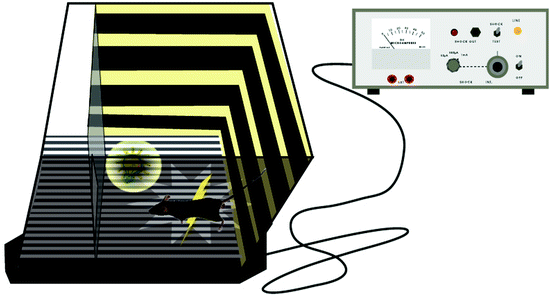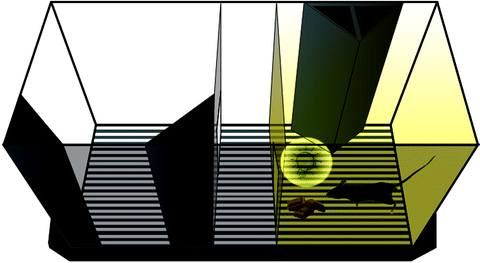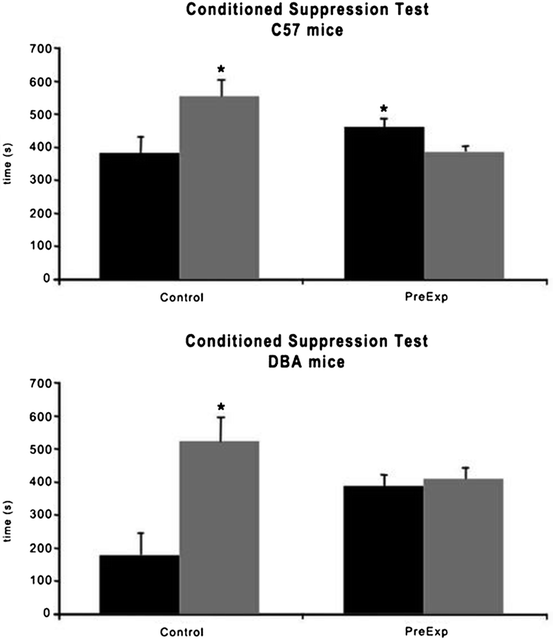Acquisition of the conditioned stimulus CS (light)-shock association was established in a different apparatus (Fig. 3) comprised of one, 15 × 15 × 20 cm Plexiglas chamber with a black and white striped pattern on two walls (to make it very different from the conditioned suppression apparatus) and with a stainless steel grid floor through which the shocks were delivered. The light was produced by a halogen lamp (10 W, Lexman), located under the grid floor, that was turned on for five, 20-s periods every 100 s; in each period, after the light had been on for 19 s, a 1-s 0.15-mA scrambled foot-shock was delivered. This session of light-shock association lasted 10 min and was followed by a 10-min rest period and then by another, identical 10-min light-shock association session; overall, the mice received ten light-foot-shock pairings in a 30-min session.


Fig. 2.
Schematic apparatus used for training phase. The apparatus used for the conditioned suppression test was a modified version of a place conditioning apparatus (50, 51, 73); it consisted of two gray Plexiglas chambers (15 × 15 × 20 cm), a central alley (15 × 5 × 20 cm), and black spatial patterns, with a stainless-steel grid floor. Two sliding doors (4 × 20 cm) connected the alley to the chambers. In each chamber two triangular parallelepipeds (5 × 5 × 20 cm) made of black Plexiglas and arranged in different pattern (always covering the same surface of the chamber) were placed to make it easier for the animals to distinguish the two chambers. A Plexiglas cup (3.8 cm diameter) was placed in each chamber: in one, the cup contained 1 g of milk chocolate (Kraft); in the other, the cup was empty. From day 1 to 4 (training phase) mice were placed individually in the alley; the sliding doors were opened to allow them to enter freely in both chambers and to explore the entire apparatus for 30 min. The time spent (s ± SEM) in each of the two chambers (i.e., the one with the cup containing chocolate and the one with the empty cup) and in the center was recorded throughout.
All experiments were carried out in experimental sound-attenuated rooms indirectly lit by a standard lamp (60 W). For all behavioral tests, data were collected and analyzed by the “EthoVision” (Noldus, The Netherlands), a fully automated video-tracking system (83). The acquired digital signal was then processed by the software to extract “time spent” (in seconds) in the chambers, which was used as raw data for preference/aversion scores in each sector of the apparatus for each subject.
2.6 Chocolate Consumption and Body Weight
Chocolate consumption was assessed during the conditioned suppression experiments. Intake was evaluated by weighing leftover chocolate at the end of each training phase session (on days 1–4), on day 7 (choice check test), and on day 9 (conditioned suppression test). Finally, mice were weighed daily throughout the experiments.
2.7 Procedures
The timeline of procedure is described in Box 1. The procedure was as follows: from day 1 to day 4 (training phase), individual mice were placed in the alley; the sliding doors were opened to allow them to enter both chambers freely and to explore the entire apparatus for 30 min (Fig. 2). The time spent in each of the two chambers (i.e., the one with the cup containing chocolate and the one with the empty cup) and in the center was recorded throughout. The choice of the chamber containing chocolate was assessed by the time spent in it. On day 5, animals were exposed to light-foot-shock pairings; acquisition of the conditioned stimulus (CS, i.e., light)-shock association was established in an apparatus with a visual–spatial pattern that was different from the one used for conditioned suppression (Fig. 3). The light was produced by a halogen lamp located under the grid floor that was turned on for five 20-s periods every 100 s; in each period, after the light had been on for 19 s, a 1-s 0.15-mA scrambled foot-shock was delivered. Overall, the mice received ten light-foot-shock pairings in a 30-min session comprising a session of light-shock association lasting 10 min and a 10-min rest period followed by an identical 10-min light-shock association session.


Fig. 3.
Schematic apparatus used for light-foot-shock pairing. Acquisition of the conditioned stimulus CS (light)-shock association was established in a different apparatus comprised of a 15 × 15 × 20 cm Plexiglas chamber with a black and white striped pattern on two walls (to make it very different from the conditioned suppression apparatus) and with a stainless-steel grid floor through which the shocks were delivered. The light was produced by a halogen lamp (10 W, Lexman), located under the grid floor, which was turned on for five, 20-s periods every 100 s. In each period, after the light had been on for 19 s, a 0.15-mA scrambled foot-shock was delivered for 1 s. This session of light-shock association lasted 10 min and was followed by a 10-min rest period and then by another, identical 10-min light-shock association session; overall, the mice received ten light-foot-shock pairings in a 30-min session.
On day 6, the mice were left undisturbed in their home cage. On day 7, the animals were subjected to the same procedure as in the training phase to evaluate whether the previous light-foot-shock pairings would affect, in a nonspecific way, the choice of the chamber containing chocolate (Choice Check Test). The mice were then returned to ad libitum feeding to rule out any effect of dietary deficiencies on the conditioned suppression test day. On day 8, the mice were left undisturbed in their home cage. Finally, on day 9, the conditioned suppression of chocolate seeking was assessed in a test session that lasted 20 min during which the mice had access to chocolate in one of the two chambers as during the training phase (Fig. 4). In the chamber containing chocolate, a CS (light) was presented according to the paradigm used for the light-foot-shock association (except for the 10-min rest period, which was discontinued). The light was produced by a lamp located under the grid floor that was turned on for 20-s periods every 100 s. This session lasted 20 min; overall, the mice received ten 20-s periods in a 20-min session. The testing session began with the first 20-s period of light. The time spent in each of the two chambers—the one containing chocolate and the other empty but safe one (the chamber in which no conditioned threatening stimulus was present)—was recorded throughout the session.


Fig. 4.
Schematic apparatus used for conditioned suppression test. Conditioned suppression of chocolate seeking was assessed in a test session (day 9 of experimental procedure) that lasted 20 min in which the mice had access to chocolate in one of the two chambers in which chocolate had been placed during the training phase. In the chamber containing chocolate, CS (light) was presented according to the paradigm used for the light-foot-shock association (except for the 10-min rest period, which was discontinued). Light was produced by a halogen lamp located under the grid floor, and was turned on for 20 s periods every 100 s. This session lasted 20 min; overall, the mice received ten, 20-s periods in a 20-min session. The testing session began with the first 20-s period of light. The time spent in each of the two chambers, one containing chocolate and the other empty but “safe” (the chamber in which no conditioned threatening stimulus was present), was recorded throughout the session.
3 Box 1
Experiment 1: two groups of mice, control and food deprived (FD), were used.
Day − 4 to 7: FD mice were placed on a moderate food-restriction schedule 5 days before the test began; this schedule was maintained until 48 h before the conditioned suppression test.
Day 1 to 4: Control (non-food-deprived) and FD mice were subjected to training phase.
Day 5: Animals were exposed to light-foot-shock pairing.
Day 6: Mice were left undisturbed in their home cage.
Day 7: Animals were subjected to the choice check test and then FD animals were returned to ad libitum feeding.
Day 8: Mice were left undisturbed in their home cage.
Day 9: Animals were subjected to the conditioned suppression test.
Experiment 2: two groups of FD mice, Sham (Sham FD) and norepinephrine (NE) depleted (NE-depleted FD), were used.
Day −4 to 7: Both groups were placed on a moderate food-restriction schedule; this schedule was maintained until 48 h before the conditioned suppression test. Moreover, other two groups of animals were used to evaluate the effects of prefrontal NE depletion in control (non-food-deprived) animals: Sham control and NE-depleted control. Before the training phase started mice were randomly assigned to one of the two groups (Sham, NE depleted) and subjected to surgery. Both control deprived and FD groups were subjected to surgery and after 7 days they were used for the behavioral test. From day −4 to 7 day, FD mice (Sham, NE depleted) were subjected to the food restriction procedure.
Day 1 to 4: Both control and FD groups were subjected to the training phase.
Day 5: Animals were exposed to light-foot-shock pairing.
Day 6: Mice were left undisturbed in their home cage.
Day 7: Animals were subjected to the choice check test and then FD groups were returned to ad libitum feeding.
Day 8: Mice were left undisturbed in their home cage.
Day 9: Animals were subjected to the conditioned suppression test.
4 Notes
4.1 Animals and Palatable Foods
While we used C57 mice, various inbred, outbred, and genetically modified mice may be used in this test. We are currently using another inbred strain (DBA/2J) to evaluate sensitivity of our procedure, possibility to generalize our results, and in order to investigate how genetic and environmental factors interact to produce pathological eating behavior.
Moreover, while we used milk chocolate as palatable food, other different foods could be employed, based on preference of specific strain employed. Preliminary data suggest the possibility to use white chocolate in C57 mice, but different experiments are needed to verify it. Numerous behavioral test, like conditioned place preference test, may be used to obtain preliminary information regarding rewarding properties or palatability of new, different foods.
4.2 Food Restriction and Different Stressful Conditions
We investigated whether the ability of a foot-shock-paired conditioned stimulus to suppress chocolate-seeking behavior was reversed by previous exposure to a food restriction experience. However, other stressful conditions could be employed to investigate whether our results may be generalized to different environmental conditions and acute or chronic stressful events.
Compulsive drug seeking has been shown only to emerge following an extended history of drug taking (9, 10), as well as compulsive eating emerges following extended access to a palatable diet (22). In agreement with these data, preliminary data from our laboratory suggest that extended access to chocolate is able to transform adaptive food-seeking/intake behavior into compulsive eating, depending on genotype (unpublished observation). Finally, our experimental procedure could be used to test relapse to compulsive-like behavior after different times from the end of the conditioned suppression test.
4.3 Selective NE Depletion and Pharmacological Treatments
To test the hypothesis that prefrontal NE transmission plays a major role in maladaptive food-related behavior, we assessed the effects of selective norepinephrine inactivation in medial prefrontal cortex on a conditioned suppression test in stressed (calorie-restricted) mice. However, our behavioral procedure could be used to investigate effects of many pharmacological treatments and to test the selective role of different neurotransmitters in specific brain areas. Moreover, genetically modified mice (mutant, transgenic, knockout) may be employed.
4.4 Chocolate Consumption and Body Weight
Chocolate consumption and body weight have to be assessed during the different steps of conditioned suppression experiments. Significant chocolate intake increase, together with increased chocolate seeking, during the test phase can be considered like compulsion-like behavior.
During the training phase and test, a Plexiglas cup (3.8 cm diameter) was placed in each chamber: in one, the cup contained 1 g of milk chocolate (Kraft); in the other, the cup was empty. However, since animals tend to move the cups, these have to be fixed on the floor to prevent mice from moving them.
4.5 Criticisms
Our data indicate that excessive chocolate seeking observed in food-deprived mice was not determined by general motivation to eat, akin to hunger, but rather by a more specific motivational state, akin to craving. However, since food-deprived mice were exposed to chocolate in the test apparatus while being food-deprived (see experimental procedures), chocolate might be more rewarding in the food deprived than in the control mice, thus making the food-deprived mice more motivated to consume chocolate during the final test. Moreover, conditioned suppression in previously food-restricted animals may involve an incentive learning process that allows the animal to assign an appropriate value to a reward that is modulated by its motivational states. This learning process is engaged when animals contact and experience the reward in the relevant state. Thus, exposure to chocolate during training, that is when animals are still in food restriction, may have increased the perceived salience of chocolate due to the motivational state induced by the feeding regimen that would lead to an increased value of the reinforcer at the moment of test, that is when animals are yet in free-feeding for 2 days. We are currently evaluating this point testing animals many days after the end of food restriction and using different stressful conditions rather than food restriction. Further experiments will be carried out in order to assess this point.
4.6 Conditioned Avoidance Test
An important point is to rule out any unspecific effects of food restriction (or different stressful conditions) or different manipulations (e.g., prefrontal NE depletion) that could affect either associative or mnemonic processes, on light-shock association. For this aim, a conditioned avoidance test or different associative tests can be used.
In our study, the conditioned avoidance test was conducted (in one group of food-deprived mice and in Sham and NE depleted groups) like the conditioned suppression test (see Sect. 3), but there was no chocolate in either of two chambers.
4.7 Shock Sensitivity
Finally, it is needed to rule out differences in shock sensitivity between different strains or between different experimental groups subjected to environmental or pharmacological treatments.
To rule out alterations in sensitivity to foot-shock induced by NE depletion, Sham food-deprived, and NE-depleted food-deprived mice were tested for foot-shock sensitivity. Individual mice were placed in the testing apparatus for a 1–2 min acclimation period; no background noise was presented during the testing period. Then, they received six series of six shocks (1 s), ranging from 15 to 150 μA, delivered at 20-s intervals through the grid floor. The series of shocks were delivered in alternating ascending and descending order; the first series was in ascending order. Shock threshold was defined as the lowest shock intensity (μA) at which an animal’s hind foot left the grid floor. For each mouse, the mean value of shock thresholds recorded in each series was calculated.
5 Conclusion
Compulsive eating despite negative consequences is evident in some people who suffer from obesity and some eating disorders such as bulimia nervosa or binge eating disorder, and is similar to the phenomenon observed with compulsive seeking/intake of drugs among addicted individuals. Because increasingly compulsive use of drugs in the face of well-known detrimental consequences is a critical behavioral feature of drug addiction, it has been suggested that compulsive overeating, particularly of refined foods, can be described as a food addiction. Indeed, such behavior conforms to the DSM-IV criteria for substance use disorders (13), and the YFAS was recently developed to operationalize the construct of palatable food dependence based on the DSM-IV-TR substance dependence criteria in humans (12). Although they are needed, studies of gene/environment interactions in human eating disorders are very rare; to date, only a few animals studies have investigated the specific role of environmental and genetic factors (and their interaction) on the development and expression of continued food seeking/intake despite possible harmful consequences (i.e., an index of compulsion) in rats (5, 22, 81) and mice (53). We are currently developing a new model of compulsive eating in mice in order to test the hypothesis that environmental factors affect eating behavior depending on genetic background. Using C57BL/6J and DBA/2J mice, two very well-characterized inbred strains, we have found that extended access to chocolate can transform adaptive food-seeking and -intake behavior into compulsive eating in C57BL/6J mice (Fig. 5, unpublished data), which were previously shown to be more sensitive to drug effects than DBA/2J mice (73). Preliminary data confirm that compulsive eating emerges following extended access to a highly palatable diet (22), similar to how compulsive drug seeking emerges following an extended history of drug taking (9, 10), but only in genetically susceptible subjects.


Fig. 5.
Conditioned suppression test in control and preexposed (PreExp) mice from C57BL/6J (C57) and DBA/2J (DBA) strains. Mean (s ± SE) time spent in chamber containing chocolate (CC, black columns) and in empty-safe chamber (E-SC, grey columns) during the conditioned suppression test by C57 (upper panel) and DBA (lower panel) animals. PreExp animals were exposed to chocolate for 7 days before the experimental procedure started. *p < 0.005 in comparison with the other chamber.
Development of well-characterized animal models of compulsive overeating will be an essential tool to advance our understanding of etiological genetic and behavioral factors involved in eating disorders, to propose targeted pharmacological therapies, and to improve appropriate cognitive behavioral therapies.
Acknowledgements
We thank Alessandro Ribaldo for figures regarding schematic representation of the apparatus and Jenna Hollenstein for helpful suggestions.
References
1.
2.
< div class='tao-gold-member'>
Only gold members can continue reading. Log In or Register to continue
Stay updated, free articles. Join our Telegram channel

Full access? Get Clinical Tree


